trailer Alfa Romeo MiTo 2013 Owner handbook (in English)
[x] Cancel search | Manufacturer: ALFA ROMEO, Model Year: 2013, Model line: MiTo, Model: Alfa Romeo MiTo 2013Pages: 312, PDF Size: 11.5 MB
Page 16 of 312
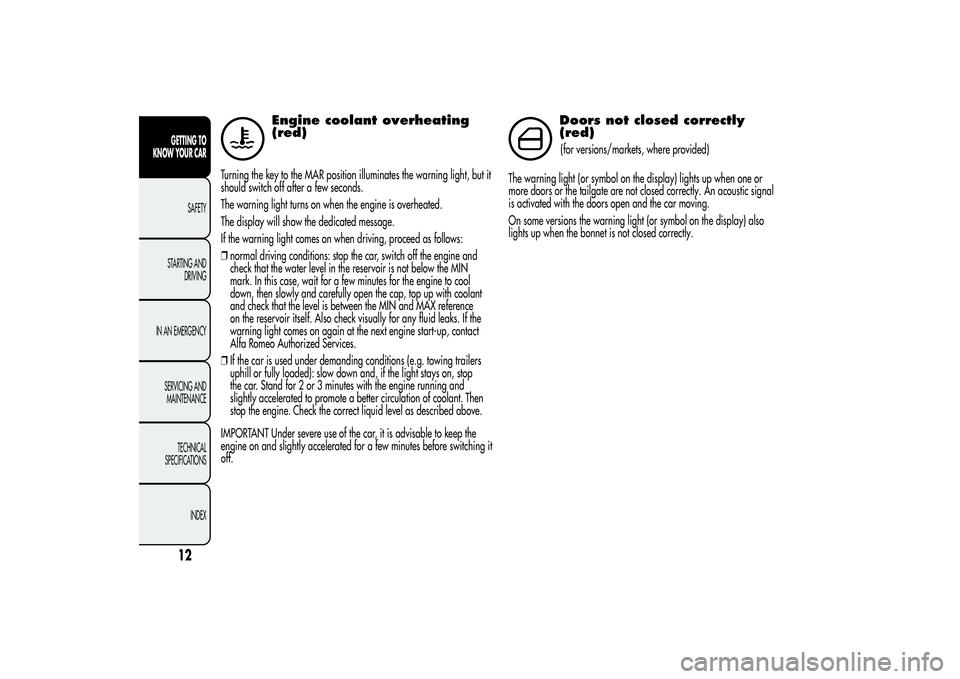
Engine coolant overheating
(red)
Turning the key to the MAR position illuminates the warning light, but it
should switch off after a few seconds.
The warning light turns on when the engine is overheated.
The display will show the dedicated message.
If the warning light comes on when driving, proceed as follows:
❒normal driving conditions: stop the car, switch off the engine and
check that the water level in the reservoir is not below the MIN
mark. In this case, wait for a few minutes for the engine to cool
down, then slowly and carefully open the cap, top up with coolant
and check that the level is between the MIN and MAX reference
on the reservoir itself. Also check visually for any fluid leaks. If the
warning light comes on again at the next engine start-up, contact
Alfa Romeo Authorized Services.
❒If the car is used under demanding conditions (e.g. towing trailers
uphill or fully loaded): slow down and, if the light stays on, stop
the car. Stand for 2 or 3 minutes with the engine running and
slightly accelerated to promote a better circulation of coolant. Then
stop the engine. Check the correct liquid level as described above.
IMPORTANT Under severe use of the car, it is advisable to keep the
engine on and slightly accelerated for a few minutes before switching it
off.
Doors not closed correctly
(red)(for versions/markets, where provided)
The warning light (or symbol on the display) lights up when one or
more doors or the tailgate are not closed correctly. An acoustic signal
is activated with the doors open and the car moving.
On some versions the warning light (or symbol on the display) also
lights up when the bonnet is not closed correctly.
12GETTING TO
KNOW YOUR CAR
SAFETY
STARTING AND
DRIVING
IN AN EMERGENCY
SERVICING AND
MAINTENANCE
TECHNICAL
SPECIFICATIONS
INDEX
Page 122 of 312

Detection distances
❒Central operating range: 140 cm
❒Side operating range: 60 cm
If several obstacles are detected by the sensors, only the nearest one is
considered.OPERATION WITH TRAILERParking sensor operation is deactivated automatically when the trailer
electric cable plug is fitted into the car tow hook socket. The sensors
are automatically enabled again when the trailer's cable plug is
removed.
The sensor must be free of mud, dirt, snow or ice in order
for the system to work. Be careful not to scratch or damage
the sensors while cleaning them. Avoid using dry, rough
or hard cloths. The sensors should be washed using clean water with
the addition of car shampoo if necessary. When using special washing
equipment such as high pressure jets or steam cleaning, clean the
sensors very quickly keeping the jet more than 10 cm away.When repainting the bumpers or touching up paint in
the sensor area, contact Alfa Romeo Authorized
Services only. Incorrect paint application could affect
the operation of the parking sensors.
Parking manoeuvres however are always the driver’s
responsibility. When carrying out such manoeuvres,
always ensure that the manoeuvring area is free of
people (particularly children) and animals. The parking sensor is
designed to assist drivers, who must still never allow their
attention to lapse during potentially dangerous manoeuvres even
if performed at low speed.
GENERAL WARNINGSDuring parking manoeuvres, pay the utmost attention to any obstacles
that could be located above or below the sensors.
Objects located near the rear of the car are not detected under certain
circumstances and could therefore cause damage to the car or be
damaged.
The following conditions may influence the performance of the parking
sensor system:
❒reduced sensor sensitivity and a reduction in the parking assistance
system performance could be due to the presence on the surface of
the sensor of: ice, snow, mud, thick paint
❒the sensors may detect a non-existent obstacle (echo interference)
due to mechanical interference, for example when washing the
car, in rain (strong wind), hail;
❒The signals sent by the sensors can also be altered by the presence
of ultrasonic systems (e.g. pneumatic brake systems or pneumatic
drills) near the vehicle.
118GETTING TO
KNOW YOUR CAR
SAFETY
STARTING AND
DRIVING
IN AN EMERGENCY
SERVICING AND
MAINTENANCE
TECHNICAL
SPECIFICATIONS
INDEX
Page 152 of 312
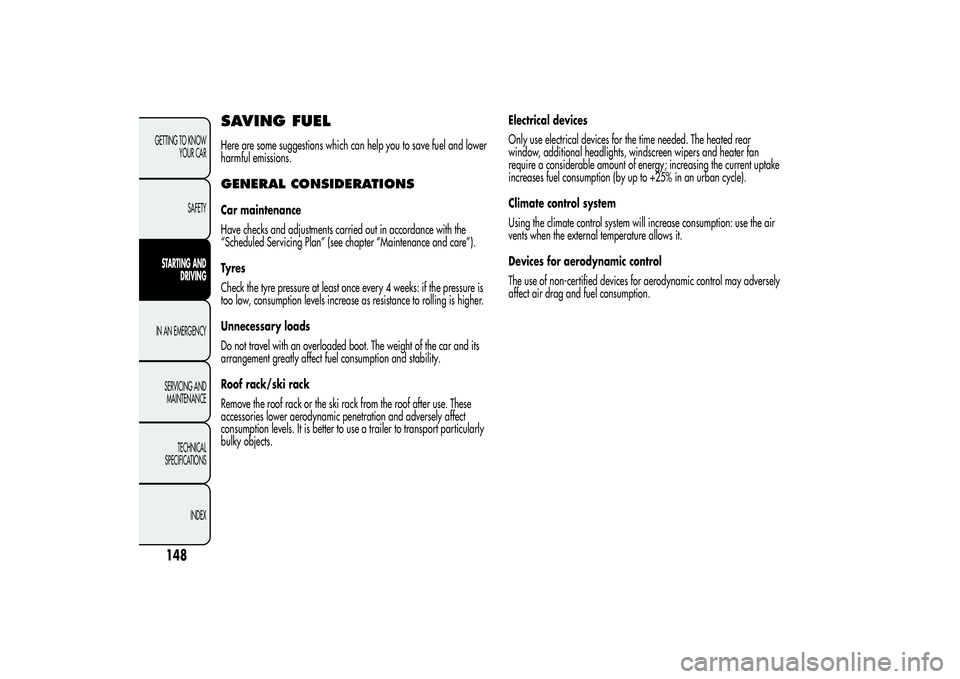
SAVING FUELHere are some suggestions which can help you to save fuel and lower
harmful emissions.GENERAL CONSIDERATIONSCar maintenance
Have checks and adjustments carried out in accordance with the
“Scheduled Servicing Plan” (see chapter “Maintenance and care”).
Ty r e s
Check the tyre pressure at least once every 4 weeks: if the pressure is
too low, consumption levels increase as resistance to rolling is higher.
Unnecessary loads
Do not travel with an overloaded boot. The weight of the car and its
arrangement greatly affect fuel consumption and stability.
Roof rack/ski rack
Remove the roof rack or the ski rack from the roof after use. These
accessories lower aerodynamic penetration and adversely affect
consumption levels. It is better to use a trailer to transport particularly
bulky objects.Electrical devices
Only use electrical devices for the time needed. The heated rear
window, additional headlights, windscreen wipers and heater fan
require a considerable amount of energy; increasing the current uptake
increases fuel consumption (by up to +25% in an urban cycle).
Climate control system
Using the climate control system will increase consumption: use the air
vents when the external temperature allows it.
Devices for aerodynamic control
The use of non-certified devices for aerodynamic control may adversely
affect air drag and fuel consumption.
148GETTING TO KNOW
YOUR CAR
SAFETYSTARTING AND
DRIVINGIN AN EMERGENCY
SERVICING AND
MAINTENANCE
TECHNICAL
SPECIFICATIONS
INDEX
Page 154 of 312

TOWING TRAILERSIMPORTANT
The vehicle must be provided with a type-approved tow hook and
adequate electrical system to tow caravans or trailers. Installation must
be carried out by a specialist.
Fit any specific and/or additional rear view mirrors as specified by the
Highway Code.
Remember that, when towing a trailer, steep hills are harder to climb,
braking distances increase and overtaking takes longer relative to
the overall weight of the trailer.
Engage a low gear when driving downhill, rather than constantly using
the brake.
The weight of the trailer reduces the load capacity of the car by the
same amount. Consider the weight at full load, including accessories
and luggage, to make sure you do not exceed the maximum towable
weight (shown in the registration document).
Respect the speed limits specific to each country for vehicles towing
trailers. In any case do not exceed 100 km/h.
INSTALLING A TOW HOOKContact Alfa Romeo Authorised Services to install a tow hook.
The ABS with which the car is equipped will not control
the braking system of the trailer. Particular caution is
therefore required on slippery roads.Do not, under any circumstances, modify the vehicle's
braking system to control the trailer breaking system.
The towing breaking system must be completely
independent of the vehicle's hydraulic system.
150GETTING TO KNOW
YOUR CAR
SAFETYSTARTING AND
DRIVINGIN AN EMERGENCY
SERVICING AND
MAINTENANCE
TECHNICAL
SPECIFICATIONS
INDEX
Page 196 of 312
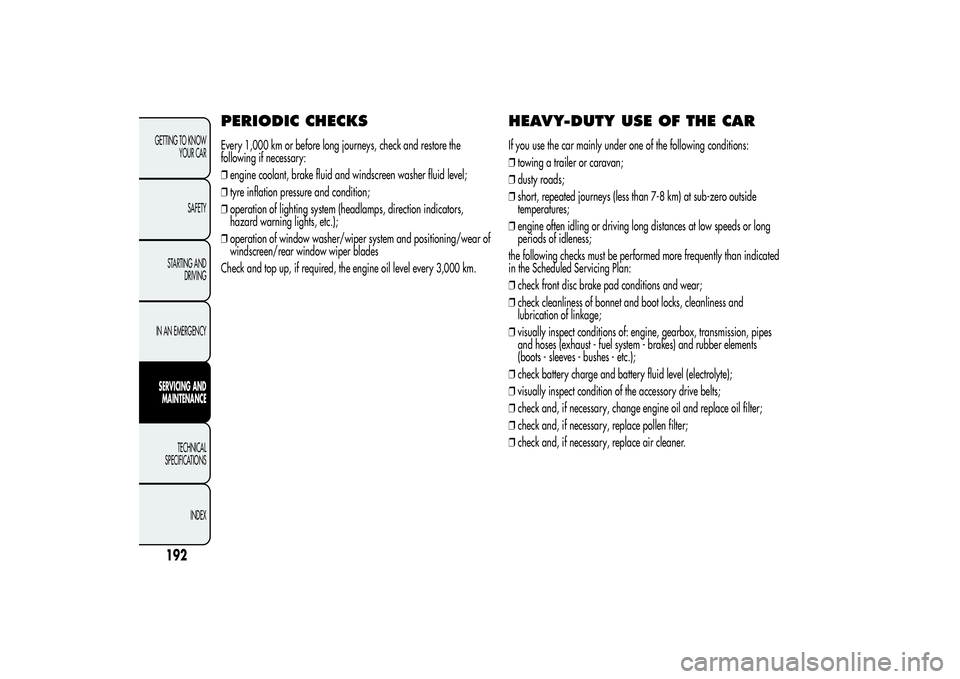
PERIODIC CHECKSEvery 1,000 km or before long journeys, check and restore the
following if necessary:
❒engine coolant, brake fluid and windscreen washer fluid level;
❒tyre inflation pressure and condition;
❒operation of lighting system (headlamps, direction indicators,
hazard warning lights, etc.);
❒operation of window washer/wiper system and positioning/wear of
windscreen/rear window wiper blades
Check and top up, if required, the engine oil level every 3,000 km.
HEAVY-DUTY USE OF THE CARIf you use the car mainly under one of the following conditions:
❒towing a trailer or caravan;
❒dusty roads;
❒short, repeated journeys (less than 7-8 km) at sub-zero outside
temperatures;
❒engine often idling or driving long distances at low speeds or long
periods of idleness;
the following checks must be performed more frequently than indicated
in the Scheduled Servicing Plan:
❒check front disc brake pad conditions and wear;
❒check cleanliness of bonnet and boot locks, cleanliness and
lubrication of linkage;
❒visually inspect conditions of: engine, gearbox, transmission, pipes
and hoses (exhaust - fuel system - brakes) and rubber elements
(boots - sleeves - bushes - etc.);
❒check battery charge and battery fluid level (electrolyte);
❒visually inspect condition of the accessory drive belts;
❒check and, if necessary, change engine oil and replace oil filter;
❒check and, if necessary, replace pollen filter;
❒check and, if necessary, replace air cleaner.
192GETTING TO KNOW
YOUR CAR
SAFETY
STARTING AND
DRIVING
IN AN EMERGENCYSERVICING AND
MAINTENANCE
TECHNICAL
SPECIFICATIONS
INDEX
Page 216 of 312

TECHNICAL SPECIFICATIONS
IDENTIFICATION DATAThe identification details of the car are:
❒V.I.N. plate;
❒Chassis marking;
❒Body paintwork identification plate;
❒Engine marking.
V.I.N. PLATEThis is located on the left side of the rear luggage compartment floor
and bears the following data fig. 170:BType-approval number.CVehicle type identification codeDChassis serial number.EMaximum authorised weight of vehicle fully ladenFMaximum authorised weight of vehicle fully laden plus trailer.GMaximum permitted weight on first (front) axleHMaximum permitted weight on second (rear) axleIEngine type.LBodywork version code.M
Spares number.
NCorrect value of smoke coefficient (for diesel engines)
fig. 170
A0J0161
212GETTING TO KNOW
YOUR CAR
SAFETY
STARTING AND
DRIVING
IN AN EMERGENCY
SERVICING AND
MAINTENANCE
TECHNICAL
SPECIFICATIONS
INDEX
Page 241 of 312
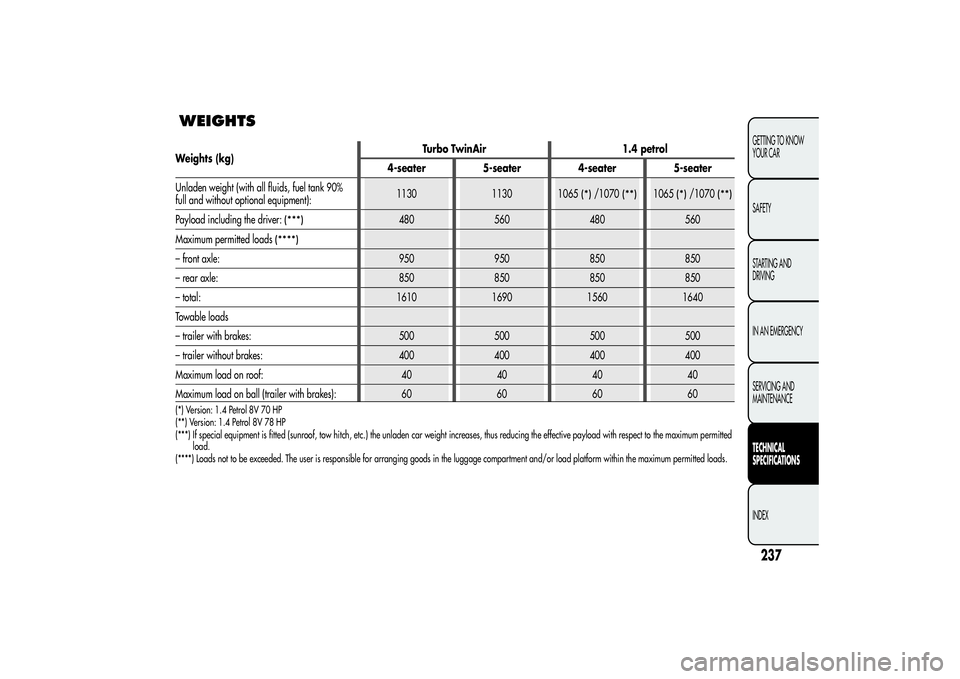
WEIGHTS
237GETTING TO KNOW
YOUR CAR
SAFETY
STARTING AND
DRIVING
IN AN EMERGENCY
SERVICING AND
MAINTENANCETECHNICAL
SPECIFICATIONSINDEX
Weights (kg)Turbo TwinAir 1.4 petrol
4-seater 5-seater 4-seater 5-seater
Unladen weight (with all fluids, fuel tank 90%
full and without optional equipment):1130 1130
1065
(*)
/1070
(**)
1065
(*)
/1070
(**)
Payload including the driver:
(***)
480 560 480 560
Maximum permitted loads
(****)
– front axle: 950 950 850 850
– rear axle: 850 850 850 850
– total: 1610 1690 1560 1640
Towable loads
– trailer with brakes: 500 500 500 500
– trailer without brakes: 400 400 400 400
Maximum load on roof: 40 40 40 40
Maximum load on ball (trailer with brakes): 60 60 60 60(*) Version: 1.4 Petrol 8V 70 HP
(**) Version: 1.4 Petrol 8V 78 HP
(***) If special equipment is fitted (sunroof, tow hitch, etc.) the unladen car weight increases, thus reducing the effective payload with respect tothe maximum permitted
load.
(****) Loads not to be exceeded. The user is responsible for arranging goods in the luggage compartment and/or load platform within the maximum permitted loads.
Page 242 of 312
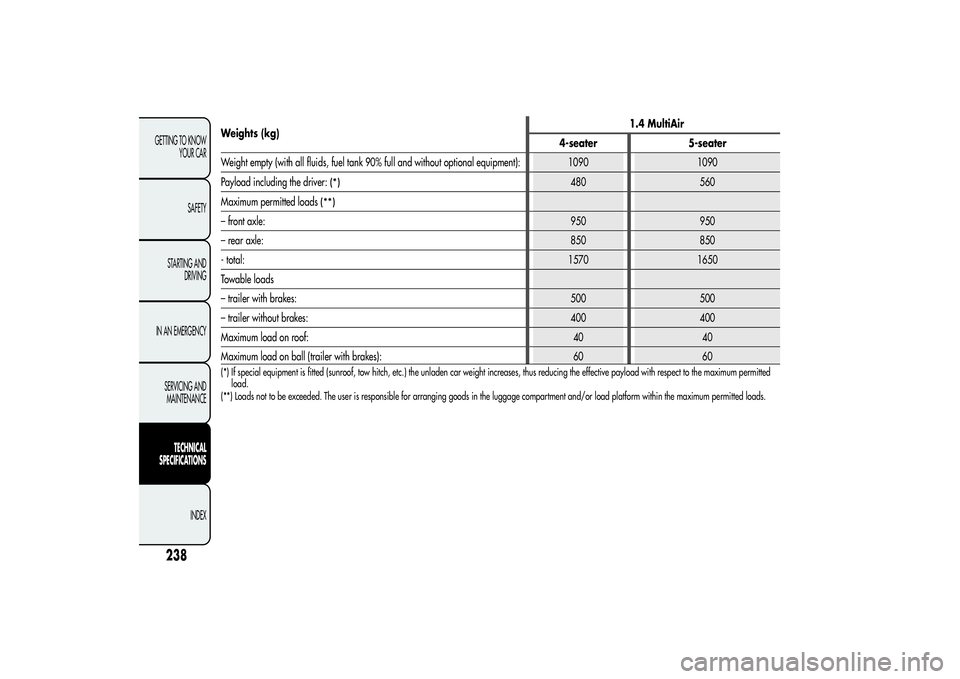
Weights (kg)1.4 MultiAir
4-seater 5-seater
Weight empty (with all fluids, fuel tank 90% full and without optional equipment): 1090 1090
Payload including the driver:
(*)
480 560
Maximum permitted loads
(**)
– front axle:950 950
– rear axle:850 850
- total:1570 1650
Towable loads
– trailer with brakes: 500 500
– trailer without brakes: 400 400
Maximum load on roof: 40 40
Maximum load on ball (trailer with brakes): 60 60(*) If special equipment is fitted (sunroof, tow hitch, etc.) the unladen car weight increases, thus reducing the effective payload with respect to the maximum permitted
load.
(**) Loads not to be exceeded. The user is responsible for arranging goods in the luggage compartment and/or load platform within the maximum permitted loads.
238GETTING TO KNOW
YOUR CAR
SAFETY
STARTING AND
DRIVING
IN AN EMERGENCY
SERVICING AND
MAINTENANCE
TECHNICAL
SPECIFICATIONS
INDEX
Page 243 of 312
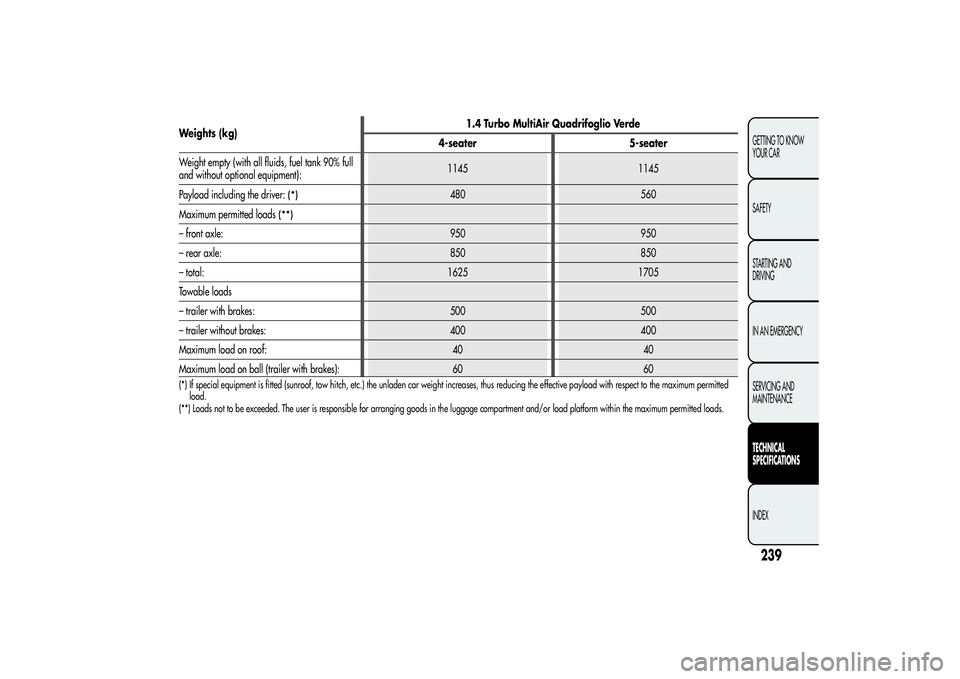
Weights (kg)1.4 Turbo MultiAir Quadrifoglio Verde
4-seater 5-seater
Weight empty (with all fluids, fuel tank 90% full
and without optional equipment):1145 1145
Payload including the driver:
(*)
480 560
Maximum permitted loads
(**)
– front axle: 950 950
– rear axle: 850 850
– total: 1625 1705
Towable loads
– trailer with brakes: 500 500
– trailer without brakes: 400 400
Maximum load on roof: 40 40
Maximum load on ball (trailer with brakes): 60 60(*) If special equipment is fitted (sunroof, tow hitch, etc.) the unladen car weight increases, thus reducing the effective payload with respect to the maximum permitted
load.
(**) Loads not to be exceeded. The user is responsible for arranging goods in the luggage compartment and/or load platform within the maximum permitted loads.
239GETTING TO KNOW
YOUR CAR
SAFETY
STARTING AND
DRIVING
IN AN EMERGENCY
SERVICING AND
MAINTENANCETECHNICAL
SPECIFICATIONSINDEX
Page 244 of 312
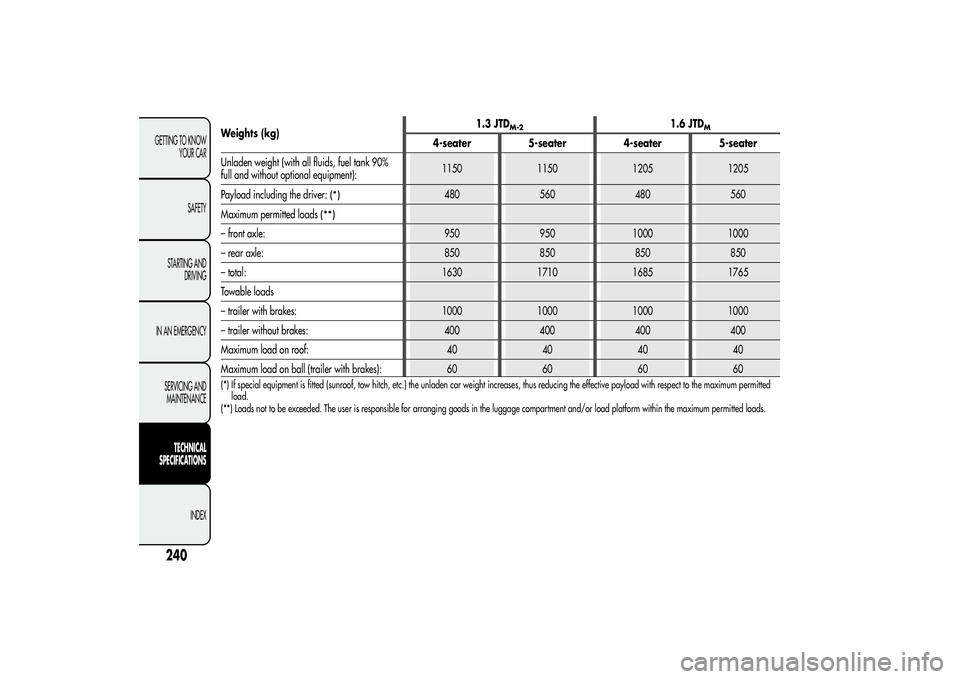
Weights (kg)1.3 JTD
M-2
1.6 JTD
M
4-seater 5-seater 4-seater 5-seater
Unladen weight (with all fluids, fuel tank 90%
full and without optional equipment):1150 1150 1205 1205
Payload including the driver:
(*)
480 560 480 560
Maximum permitted loads
(**)
– front axle: 950 950 1000 1000
– rear axle: 850 850 850 850
– total: 1630 1710 1685 1765
Towable loads
– trailer with brakes: 1000 1000 1000 1000
– trailer without brakes: 400 400 400 400
Maximum load on roof: 40 40 40 40
Maximum load on ball (trailer with brakes): 60 60 60 60(*) If special equipment is fitted (sunroof, tow hitch, etc.) the unladen car weight increases, thus reducing the effective payload with respect to the maximum permitted
load.
(**) Loads not to be exceeded. The user is responsible for arranging goods in the luggage compartment and/or load platform within the maximum permitted loads.
240GETTING TO KNOW
YOUR CAR
SAFETY
STARTING AND
DRIVING
IN AN EMERGENCY
SERVICING AND
MAINTENANCE
TECHNICAL
SPECIFICATIONS
INDEX